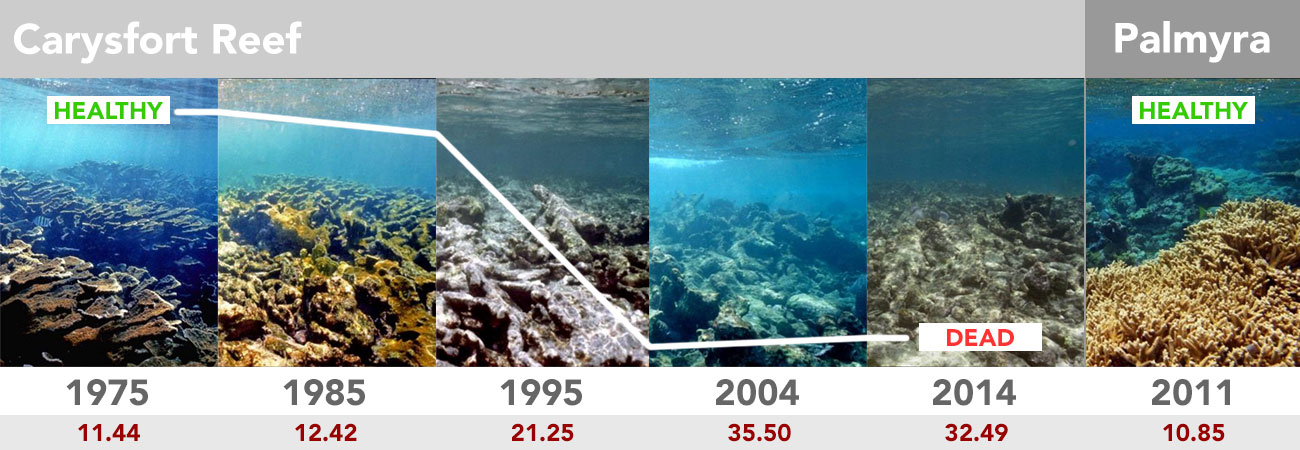About the Phage to Shark Project
Reefs in Decline

A dramatic time series of photos documenting the 95 percent loss of coral cover from Carysfort Reef, Key Largo, Florida since 1975. The photos capture the loss of a once thriving colony of elkhorn coral, Acropora palmata (Photos: Phil Dustan).
The first five images were taken at the identical location on Carysfort Reef, over a time span of 40 years. The aesthetic value (in red) calculated for each image shows a significant degradation of aesthetic appearance during this period. The lower the number the more aesthetically pleasing an image is predicted to be. The historic images from 1975 indicate that the aesthetic appearance of this Caribbean reef was comparable to present day pristine reefscapes as for example on Palmyra atoll in the Central Pacific (the last image, photo taken by J Smith).
The Phage to Shark Project
In conservation, there is a prevailing opinion that coral reefs can be conserved by simply protecting the grazers at lower trophic levels (e.g., urchins, parrotfish). Indeed, the human consumption of these animals represents one of the last (and best-studied) nails-in-the-coffin for the decline of coral reefs because when allowed to remain on the reef these animals scrape fast-growing algae from reefs and help clear habitat for corals. However, data from studies of pristine reefs in the remote Pacific strongly suggest that herbivores alone cannot stabilize or rescue a coral reef because they do not consume enough of the energy produced by photosynthesizers. In full sun year-round, reef algae produce huge amounts of excess energy in the form of sugars which, when released into the water, fuel the growth of bacteria on and around corals.
To remove this excess energy and store it in a reservoir inaccessible to coral pathogens and opportunistic bacteria, it is necessary to have higher trophic levels, like sharks and big groupers to continually consume and store this energy (Sandin et al., 2008). An ecological "rule-of-thumb" is that as energy moves from one trophic level to another, 90% of the energy is lost as heat or as waste (Lindeman 1942). Therefore, if 100 grams of sugar are produced per square meter (by photosynthesis on the benthos by corals and algae), then 10 grams of grazers can survive in this area if they eat everything. And 1 gram of sharks will be supported by eating these grazers. So it takes roughly 10,000 kg of primary production (a huge swath of reef) to support the dietary needs of a 100 kg shark. Therefore, removing the sharks from a coral reef dramatically reduces the rate at which the coral reef "burns" energy; the excess sugar ends up unconsumed in the water column, where it is fast fuel for feeding microbes. These microbes then go on to kill corals (Smith et al. 2006).
The goal of the Phage-to-Shark Pew project is to use the Metabolic Theory of Ecology (MTE) to quantify how removing sharks (or any other component of the food web) influences the other parts of a coral reef ecosystem. We have created the Reef Energetics Tool to visually explore the links between the reef's smallest predators, the phage, and top apex predators including sharks, and to demonstrate how this influences coral health.

